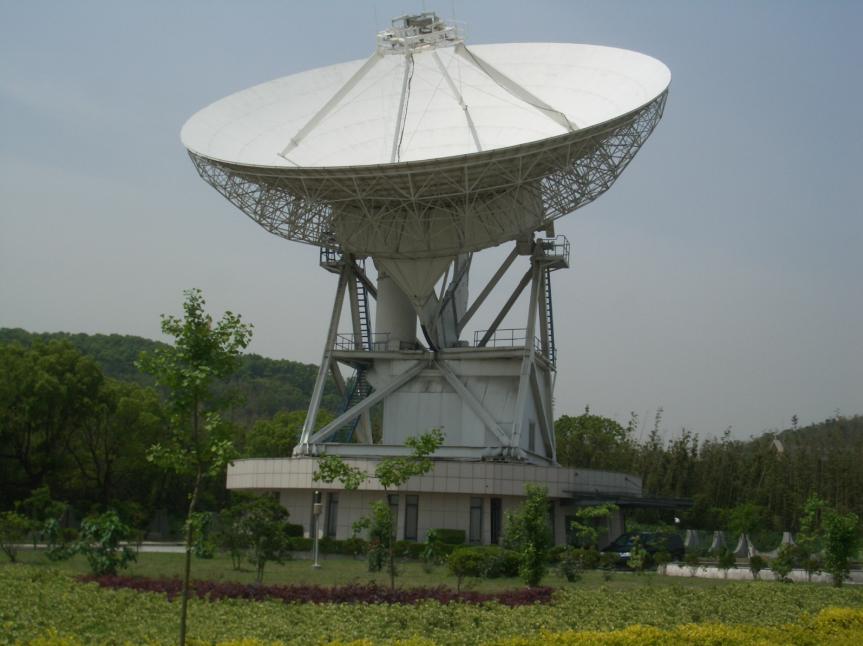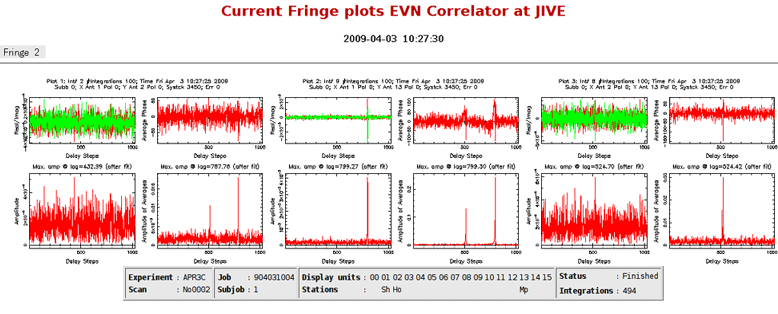Shanghai Radio Telescope participated in "100 Hours of Astronomy" with live webcast and e-VLBI observations
Shanghai Radio Telescope participated in "100 Hours of Astronomy" with live webcast and e-VLBI observations
[5 April 2009, Shanghai, China] - The Shanghai Radio Telescope of the Shanghai Astronomical Observatory (SHAO) showcased the VLBI astronomical technique in the "100 Hours of Astronomy" with a live webcast on Saturday 4 April and e-VLBI observations on Friday 3 April and Sunday 5 April. “The 100 Hours of Astronomy” is a cornerstone project of the International Year of Astronomy, taking place over four days and nights from 2-5 April 2009.

“Around the World in 80 Telescopes” is one of the important global events during the “100 Hours of Astronomy”. It is a unique live 24-hour webcast worldwidely, demonstrating what is happening at some of the most advanced observatories both on and off the Earth. Shanghai Radio Telescope of the SHAO, as the penultimate “actor”, was appearing in the live webcast at 16:40 local time (08:40 GMT). The recorded show can be viewed at http://www.ustream.tv/recorded/1340652. During the total 16-minute timeslot for Shanghai Radio Telescope, a pre-recorded video first show the brief history and current status of the Shanghai Astronomical Observatory, the major research facilities as well as the research fields in the observatory. In the remaining 10 minutes, two radio astronomers from the SHAO, Prof. Zhi-Qiang SHEN (Chief of the VLBI Division) and Dr. Tao AN, were taking an interactive interview with the host from the European Southern Observatory (ESO) at Garching, Germany. They introduced the observing system and international collaboration of the Shanghai 25-meter radio telescope, the various researches carried out by the radio astronomers in the observatory. Prof. Zhi-Qiang Shen answered two questions raised by the public who are interesting in the VLBI tracking of the Chinese lunar satellite (Chang’E-1) in 2007 and the features of the new 65-meter radio telescope that is under construction. At the end of the interview, Zhi-Qiang Shen invites astronomers and the public around the world to visit Shanghai in this summer to witness the total solar eclipse in this region.

In order to celebrate the development of the astronomical telescope and observing technique since the first time Galileo pointed the telescope toward the night sky 400 years ago, the Joint Institute for VLBI in Europe (JIVE), on behalf of the European VLBI Network (EVN), coordinated a global real-time VLBI experiment on 3rd and 5th April. About 14 telescopes in Australia, Chile, China, Finland, Germany, Italy, the Netherlands, Poland, Puerto Rico, Spain, Sweden and, the UK participated in the live demonstration observations. The real-time VLBI network observed an active galaxy called 3C120, as well as quasars PKS 0727-115 and PKS 0234+285. Data from all the telescopes were streamed electronically to JIVE in the Netherlands where these are processed in real-time by a purpose-built supercomputer called correlator. This technique, called electronic, real-time Very Long Baseline Interferometry or e-VLBI, is capable of producing images of cosmic radio sources with up to one hundred times better resolution than images from the best optical telescopes. The data analysis process and the results are shown in the program webpage http://iya.expres-eu.org/.
The e-VLBI observations are made possible by the Express Production Real-time e-VLBI Service (EXPReS) and the cooperation of participating radio observatories and National Research and Education Networks including the Chinese Science and Technique Network (CSTNET).
**************
About the Shanghai Astronomical Observatory
Shanghai Astronomical Observatory (SHAO) is an institute of the Chinese Academy of Sciences (CAS).The observatory's main research activities fall into four divisions: astro-geodynamics, Galaxies and Cosmology,Very-Long-Baseline-Interferometry (VLBI), and astronomical techniques. Its observing facilities include a 25-meter radio telescope used for VLBI, a 1.56-meter optical telescope, and a 60-centimeter satellite laser-ranging system (SLR). There are also three technical laboratories, developing hydrogen atomic clocks, VLBI equipments, and optical astronomy. SHAO is responsible for the VLBI and SLR networks of the National Astronomical Observatory of China (NAOC). It also hosts the central office of the Asia-Pacific Space Geodynamics Program (APSG), as well as a partner group of the Max Planck Institute for Astrophysics (MPA).
About the Shanghai Radio Telescope
The Shanghai Radio Telescope of Shanghai Astronomical Observatory (SHAO) is located at the foot of Sheshan, 40 km west of Shanghai. It is a paraboloid-type antenna with a 25-meter diameter. The telescope has been in full operation since 1987. It is one of major astronomical facilities of the NAOC. The Shanghai Radio Telescope is a member of the International VLBI Service (IVS), European VLBI Network (EVN) and Asia-Pacific Telescope (APT) and Chinese VLBI Network (CVN). It involves actively in domestic and international VLBI observations. In 2007, the Shanghai Radio Telescope along with other three Chinese radio telescopes participated in the Chinese Lunar Project -- VLBI tracking of the Chang'E-1 satellite – to determine the orbital parameters almost in real-time.
About VLBI and e-VLBI
Very Long Baseline Interferometry (VLBI) is an astronomical technique by which multiple telescopes observe the same region of sky simultaneously. Data from each telescope is sampled and sent to a central processor which decodes, aligns and correlates the data for every possible pair of telescopes, allowing astronomers to generate images of cosmic radio sources with up to one hundred times better resolution than images from the best optical telescopes. Instead of the traditional VLBI observations of recording data onto disks and shipping them to the correlator, electronic, real-time VLBI (e-VLBI) uses networks to stream the data electronically to the correlator for processing in real-time, allowing for on-the-fly telescope adjustments during observations and providing astronomers with data in a matter of hours rather than weeks or months.
About the 100 Hours of Astronomy
The 100 Hours of Astronomy Cornerstone Project (www.100hoursofastronomy.org) is a worldwide event consisting of a wide range of public outreach activities, science center activities, research observatory webcasts and sidewalk astronomy events. One of the key goals of 100 Hours of Astronomy is to have as many people as possible look through telescopes, just as Galileo did for the first time 400 years ago.
Contact :
Xiaoyu HONG, Director of Shanghai Astronomical Observatory
Shanghai Astronomical Observatory
+86 21 64386191 503
xhong@shao.ac.cn
Zhi-Qiang SHEN, Chief of VLBI Division
Shanghai Astronomical Observatory
+86 21 64386191 221
zshen@shao.ac.cn
Tao AN, VLBI friend of Shanghai Radio Telescope
Shanghai Astronomical Observatory
+86 21 64386191 509
antao@shao.ac.c
Download attachments: